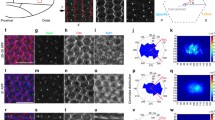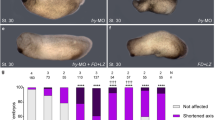Abstract
The Wnt/planar cell polarity (PCP) signaling pathway plays a critical role in wing, eye, neural tube defects, and sensory bristle development of Drosophila and vertebrate development. Recently, the Wnt/PCP pathway has been known to regulate convergent extension (CE) movements that are essential for establishing the three germ layers and body axis during early vertebrate development. Here, we describe detailed practical procedures required for the particular studies in Xenopus CE movements
Access this chapter
Tax calculation will be finalised at checkout
Purchases are for personal use only
Similar content being viewed by others
References
Veeman MT, Axelrod JD, Moon RT. (2003) A second canon. Functions and mechanisms of beta-catenin-independent Wnt signaling. Dev Cell Sep;5(3):367–77.
Wallingford JB, Fraser SE, Harland RM. (2002) Convergent extension: the molecular control of polarized cell movement during embryonic development. Dev Cell Jun;2(6):695–706.
Myers DC, Sepich DS, Solnica-Krezel L. (2002) Convergence and extension in vertebrate gastrulae: cell movements according to or in search of identity? Trends Genet Sep;18(9):447–55.
Wallingford JB, Habas R. (2005) The developmental biology of Dishevelled: an enigmatic protein governing cell fate and cell polarity. Development Oct;132(20):4421–36.
Tada M, Smith JC. (2000) Xwnt11 is a target of Xenopus Brachyury: regulation of gastrulation movements via Dishevelled, but not through the canonical Wnt pathway. Development May;127(10):2227–38.
Djiane A, Riou J, Umbhauer M, Boucaut J, Shi D. (2000) Role of frizzled 7 in the regulation of convergent extension movements during gastrulation in Xenopus laevis. Development Jul;127(14):3091–100.
Kim GH, Han JK. (2007) Essential role for beta-arrestin 2 in the regulation of Xenopus convergent extension movements. EMBO J May 16;26(10):2513–26.
Kim GH, Han JK. (2005) JNK and ROKalpha function in the noncanonical Wnt/RhoA signaling pathway to regulate Xenopus convergent extension movements. Dev Dyn Apr;232(4):958–68.
Wacker S, Grimm K, Joos T, Winklbauer R. (2000) Development and control of tissue separation at gastrulation in Xenopus. Dev Biol Aug 15;224(2):428–39.
Winklbauer R, Medina A, Swain RK, Steinbeisser H. (2001) Frizzled-7 signalling controls tissue separation during Xenopus gastrulation. Nature Oct 25;413(6858):856–60.
Ren XD, Kiosses WB, Schwartz MA. (1999) Regulation of the small GTP-binding protein Rho by cell adhesion and the cytoskeleton. EMBO J Feb 1;18(3):578–85.
Park E, Kim GH, Choi SC, Han JK. (2006) Role of PKA as a negative regulator of PCP signaling pathway during Xenopus gastrulation movements. Dev Biol Apr 15;292(2):344–57.
Sive HL, Grainger RM, Harland RM. (2000) Early Development of Xenopus laevis: A Laboratory Manual. Cold Spring Harbor Laboratory Press.
Nieuwkoop PD, Faber J. (1967) Normal table of Xenopus laevis (Daudin). Amsterdam: North Holland.
Acknowledgments
We acknowledge Mi-Jung Kim and other members of our laboratory for reading this manuscript and providing constructive criticism. This work was supported by the National Research Foundation of Korea (KRF) grant (No. 20090092829) and K-MeP project (T31130) of Korea Basic Science Institute (KBSI).
Author information
Authors and Affiliations
Corresponding author
Editor information
Editors and Affiliations
Rights and permissions
Copyright information
© 2012 Springer Science+Business Media, LLC
About this protocol
Cite this protocol
Kim, GH., Park, E.C., Han, JK. (2012). Wnt/Planar Cell Polarity Signaling in the Regulation of Convergent Extension Movements During Xenopus Gastrulation. In: Turksen, K. (eds) Planar Cell Polarity. Methods in Molecular Biology, vol 839. Springer, New York, NY. https://doi.org/10.1007/978-1-61779-510-7_7
Download citation
DOI: https://doi.org/10.1007/978-1-61779-510-7_7
Published:
Publisher Name: Springer, New York, NY
Print ISBN: 978-1-61779-509-1
Online ISBN: 978-1-61779-510-7
eBook Packages: Springer Protocols




